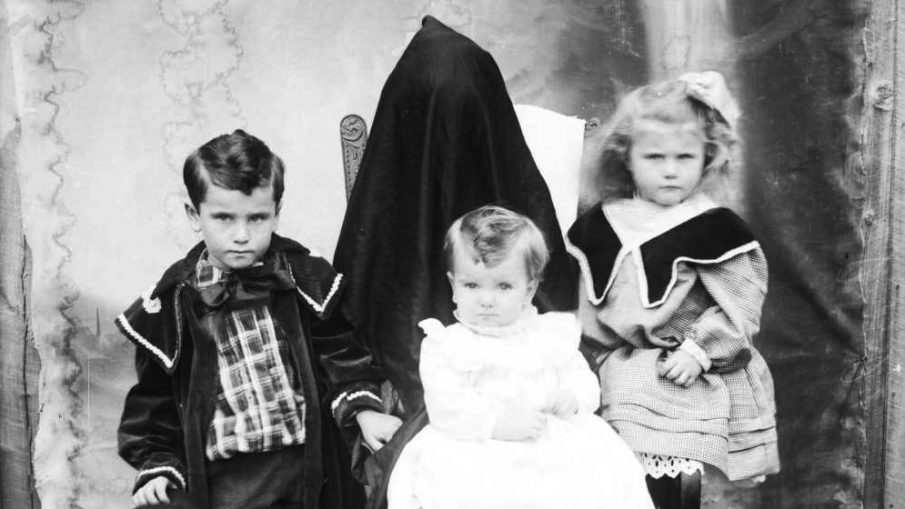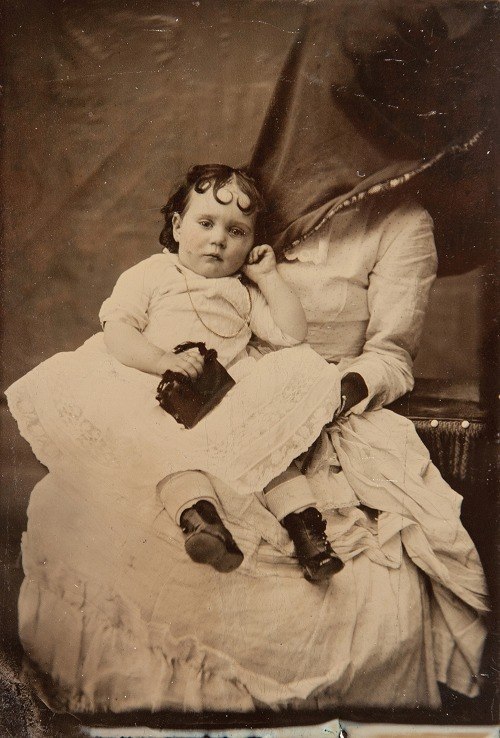
“Hidden Mothers” in the old photographs

Lately I had a pleasure to write a short text on “Victorian Post-Mortem Photography” (in Tygodnik Powszechny, in Polish), mainly focusing on confronting some popular (but erroneous) myths on this subject. No-one would really take a creepy picture of a corpse posed on a stand (those stands would not be able to hold the body straight anyway!) and paint the eye-pupils so the dead could look alive…! But today I do not want to write about “post-mortem myths”; instead I will focus on another, yet similarly fascinating subject.
All the lovers of the 19th- and early 20th-century photography are familiar with the concept of so called “hidden mothers”. Those are the photos of babies sitting on the lap of strangely covered women; the result is rather creepy, especially for a nowadays’ viewers. Why would anyone take such a photo?
The secret is in the issue of a long exposure time of the 19th century photography. To get a good and un-blurred picture the model had to stay still for at least several dozen seconds, and in earlier days even for several minutes. The easiest way to photograph an infant would be placing him or her in a chair, but in that case it would most likely be impossible to have him or her sit still. The woman holding a baby could provide him or her a necessary sense of comfort, calming the child and making him or her feel safe. As the photo may have been intended to be placed in an oval frame, after cropping the picture a woman hidden under a blanket would became a curtain-like background for the portrayed child.
But why did they cover “a mother” in the first place, instead of taking a photo of both mother and child? Most often it is assumed that the goal was to get a solo portrait of a baby. Would that be some kind of reference to the old aristocratic traditions of portraying each member of the family separately (so everyone knew one could afford so many expensive paintings)? Or perhaps it was a question of cutting down the costs; assuming that photographing more people was more expensive (e.g. due to the cost of retouching each face)? Well, I think that in the particular case of “hidden mothers” it was not about the money, but about a certain cultural issue, which is now not familiar for us anymore. Of course, in some cases one may indeed have covered the baby’s mother to get an unassisted baby’s portrait, but it makes no sense when it comes to group pictures, showing “hidden mother” among a few children. That case is a “family portrait” anyway, so why exclude a mother? Well, perhaps it was not a mother? Perhaps she did not belong to that family at all?
We do realise that a hidden woman holding a baby is most likely his or her closest person: she must have a deep relation with an infant so she could comfort him or her and make feel safe. We automatically assume that this has to be the baby’s mother, but most likely we are wrong! In the upper classes of the 19th and early 20th century biological mothers seldom took care of their children; they had nurses and nannies for that! As a result, for the well-born children back then (especially in their early infancy) a biological mother may have been almost a stranger. However, when the wealthy parents decided they wanted to have their children photographed, they obviously tried to avoid having a photo of a servant accompanying their kids. As a result I suspect that most of the “hidden mothers” are in fact only hired nannies or nurses.
The most surprising fact is that in some articles the “hidden mothers” are interpreted as related to the post-mortem photography: allegedly they would hold dead babies… That makes no sense at all, as most likely a dead baby would not need to be held to stay still! I think that this misinterpretation is based on our contemporary reception of the “hidden mothers” photos: they seem so creepy that we suspect they must have been related to the most terrifying kind of photography.
It seems that the myths which we now create around the 19th century photography are in fact the reflection of cultural changes that occurred within past 100 years. We look for sensation where there is none, for example we do not assume that the “hidden mother” may not be a mother at all. That is, by the way, very interesting: theoretically it is widely accepted today that women want to have professional careers, but on the other hand we expect them to take care of their babies themselves. Can you imagine a woman of today who would be brave enough to admit that she may have a baby, but she wants someone else to raise it, so she would not be forced to nurse the child, to get up in the middle of the night, to loose her good look and to give up her social life? Well, that was pretty common attitude for the upper classes of the 19th century. However, such a hired nurse may not have occurred in a photo with the child she took care of, no matter how close relation they had created in everyday life.









Fascinating! Are these photos in the public domain?
They are (at least according to Polish law), as their authors have been dead for more than 70 years.
Makes sense. It was common for children in upper class to be birthed by their mother and raised by a nanny.
Case in point – Russian poet Pushkin.
Raised by his nanny, was very attached to her and dedicated several poems to her. She had a great influence on his works. Not much is known about Pushkin’s relationship with his parents and certainly no poems were dedicated to them.
https://en.wikipedia.org/wiki/Alexander_Pushkin#Early_life
https://pl.wikipedia.org/wiki/Arina_Rodionowna_Jakowlewa#Miejsce_niani_w_tw%C3%B3rczo%C5%9Bci_Puszkina
Oh thank you so much for this comment! Yes, you are right, this is a very interesting example!
🙂